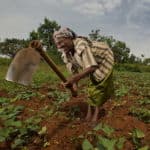Impact Investing Impasse: The Case for 4-Hour Due Diligence
We’re all used to the niceties of conferences. Disagreements are mild, sometimes so mild as to be imperceptible, as speakers and panelists politely engage from their podiums and the dais, rarely venturing off-script.
But deference to sacred cows was not what Andy Lower had in mind when he stepped up to the stage at the Social Capital Markets (SOCAP) main stage last year and flat-out called B.S.
To put it mildly, Lower doesn’t much care for how long it takes impact investors to close deals with social enterprises. Weeks can easily turn to months, while entrepreneurs squirm and investors dawdle, he says. Such delays aren’t tolerated in the tech industry, or any other industry for that matter, yet they are commonplace in the impact investing space, he argued.
Lower is the founder of A Different Approach to Poverty (ADAP Capital LLC), which is investing in early stage companies that address poverty. Along with Managing Director Dan Luscher, he devised a “four-hour due diligence” process to evaluate investments. At last year’s SOCAP they put their money where their mouth is. During the conference, the investors met with eight entrepreneurs, whom they’d never met before. In just a couple of days, they were able to come to terms and hand out big novelty checks (worth real money) to two of these entrepreneurs.
The exercise wasn’t a gimmick: ADAP’s point is that deal making should be much faster than it is – and that it’s entirely possible to make it faster, so both parties can move to the next step or walk away. ADAP will be doing rapid-fire investments again during SOCAP18 next month, so I reached out to Lower to gauge the reaction since his gauntlet throw-down last year – and to see if there’s been any thaw in the frozen impact investing process since then.
Scott Anderson: At SOCAP last year (video below), you powerfully called out the “outrageous hypocrisy” that happens there when it comes to discussions of “changing the world” at the expense of closing deals. What has been the response to that speech?
Andy Lower: I delivered that message from the main stage at SOCAP at the end of a very successful (and highly stressful!) four days at the conference. I had been getting various patronizing comments from well-known leaders in the social impact sector, as if what we were doing was a “cute stunt” and “not relevant” to the broader sector. To me, though, the real leaders are the people actually getting things done – not just talking about broad trends and theories at conferences, but pushing to close deals that empower game-changing entrepreneurs and companies with capital and advisory support. The response continues to be mixed: Some investors and entrepreneurs appreciate both the logic and effectiveness of our model, others prefer to continue to have the status quo.
SA: Another point you made in the SOCAP speech is that too often investors aren’t giving social entrepreneurs a quick yes or no, but rather “a drawn out no” during their due diligence process – “stringing along the entrepreneur.” Why do you believe this is a pervasive problem, and how does ADAP handle the due diligence and post-investment management process differently?
AL: We have seen on a far too consistent basis, investors abusing their power and privilege by not being honest or fair with entrepreneurs. One of the biggest takeaways from our SOCAP process was the need to be open about the fear factor that there is in making an investment decision. A year on, I am relieved that we still stand behind our investment decisions and the timeliness of the process. For an early-stage company, if we need to take up more than four hours of an entrepreneur’s time before we can make an informed decision about whether we want to partner with them, it’s probably not going to be a good partnership.
There have been occasions where it has not worked out for us, where a deal has been agreed in essence and then for a variety of reasons, even after term sheets have been agreed, the deal does not materialize. Often this is not necessarily any particular party’s “fault,” but rather a reflection of changing circumstances in a fast-evolving sector. But we have also experienced, on multiple occasions, other investors who have tried to exploit the nimbleness of our process and have intentionally delayed their own investment process with the goal of getting better terms, as the entrepreneur increasingly becomes desperate. The result is often perceived as a win for the investor and a loss for entrepreneurs, and yet the greatest loss is for the in-country stakeholders, clients or customers who can be further trapped in the cycle of extreme poverty.
SA: That’s a good segue to ask about the mindset when you co-founded A Different Approach to Poverty. What is different about your funds?
AL: Over the last decade of working in the early-stage impact investment sector, with a variety of organizations, there were a number of key themes that became apparent and led me to create an organization that was intentionally trying to have a different approach to poverty. Firstly, it’s our belief that investment capital is typically more effective when paired with consistent advisory support. And secondly, rather than bemoaning the “lack of investable deals,” we think the ecosystem can be built more effectively and rapidly if more investors focus on the unrealized value that early-stage investments provide. Thirdly, we think that directly and proactively addressing the often-skewed power dynamics between investors and entrepreneurs is not only the right thing to do, if we claim to be driven by impact, but also creates more opportunities for entrepreneurs to fulfill their potential. ADAP seeks to find ways to encourage all stakeholders to be focused on the end result of impact to in-country stakeholders and customers, and to collaboratively build businesses.
SA: ADAP’s first fund was launched in 2014 and invested in 11 early-stage social businesses, across sectors and in a variety of countries. I’m curious about the types of businesses you’ve invested in: Can you provide some examples?
AL: Our first fund was very experimental, intentionally investing across different sectors and different geographies. We learned a lot while working with companies to generate financial returns and social impact, and we have used the experience to further refine our criteria for Fund 2 with a more specific focus on innovation and pioneering approaches. We want to be directly impacting hundreds of thousands of lives, investing in more companies such as EFK, which is pioneering a new cash crop and agribusiness industry, and working directly with 6,000 rural Kenyan farmers – or Sevamob, which is [facilitating] AI-enabled healthcare for tens of thousands of Indian families every month. Additionally, we learned a lot from Fund 1 as to how to support these innovative companies, and we have developed and refined our ADAP Advisory offering, with a curriculum and monthly review process helping entrepreneurs to be focused on the four cornerstones needed to have good foundations for a social business.
SA: How have you attracted investors to ADAP with the fund’s strategy?
AL: We’re in the process of having our second close, and have been pleased with the progress to date. We’re excited to work with more investors and build on our established track record.
SA: Your firm aims to address the pioneer gap. Are you seeing any growth in this form of investing from other types of investors? In other words, do we have reason to hope that the proverbial “death valley” can claim fewer enterprises?
AL: A small number of business will make it through no matter what. Some businesses and ideas need to die, and throwing good money after bad money is never a good approach. However, a lot of social impact companies are not even given a fighting chance to see if they will succeed. Not only are companies expected to generate above-market rate returns, but they are also expected to be focused on achieving hockey stick growth. In order for more businesses to overcome the pioneer gap, the ecosystem needs to collaborate more and be agreed upon and focused on the ultimate goal of having social impact.
SA: You’ve just announced your ADAP SOCAP Deal Room. What is it and how does it work?
AL: Last year, we decided to showcase our different approach to due diligence and publicly perform our process. After meeting eight entrepreneurs for the first time on the Tuesday of SOCAP, we then performed our ADAP “Four-Hour Due Diligence,” and were able to reach mutually beneficial terms with two fantastic entrepreneurs that we announced from the main stage on the Friday of SOCAP.
It was great that our timely process worked publicly, and ADAP Advisory has enjoyed working with these companies since SOCAP. This year we plan to follow the same model, as well as raising more awareness about our approach with other interested partners – both entrepreneurs and investors alike. We welcome all entrepreneurs who meet our investment criteria to review our website and apply, and to join us at SOCAP18. Additionally, if there are investors that would like to learn alongside us, please email us.
SA: Finally, a big broad question: Where do you hope to see the impact investing sector in the next 10 years?
AL: I follow the evidence that impact investing as a sector is increasingly becoming mainstream. I also hope that as more data is available to prove the value for investors that is being claimed by those who are willing to embrace risks by investing in early-stage businesses, there will be more of a sellers’ market for social entrepreneurs to choose the right kind of capital for their business to effectively grow.
Scott Anderson is a contributing editor at NextBillion.
Image via Pexels.
- Categories
- Investing, Social Enterprise
- Tags
- impact investing



